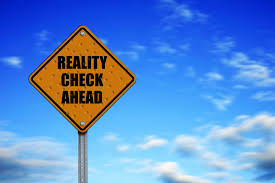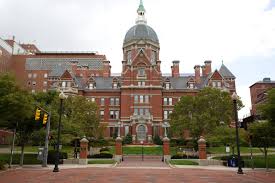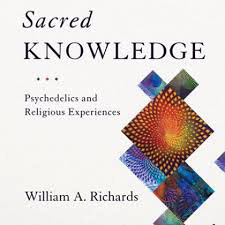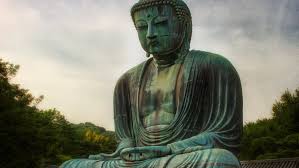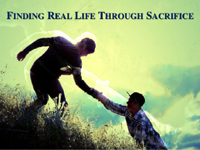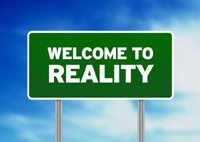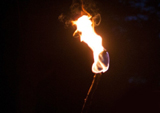Consciousness and health
What is Real?
An exploration into the deeper workings of Real and Reality
Abstract
In this article, the author turns to cutting-edge scientific findings, ancient Buddhist principles and modern-day psychology in an attempt to find illuminating pathways to the question of what is real.
In order to address the broad questions of what is real, what is reality and what is truth, it appears meaningful to ask the following questions: how do we humans construct our reality; what is the process; where does it come from? To help us explore these questions, we will turn to modern-day science, ancient Buddhist metaphysics and current psychological principles.
Modern science
Modern science is blazing new ground in helping us understand how the human brain functions. Cutting-edge research on the therapeutic use of entheogens (1) is revealing previously unsubstantiated findings and promising applications as curative medicinal agents and facilitators for the expansion of consciousness. Entheogens is a term coined by a prominent group of ethno-botanists and mythologists in 1979 to differentiate it from psychedelics, which had taken on a negative connotation due to recreational misuse and 1960s counter-cultural associations.
Entheogens are psycho-active substances that have been used by indigenous people in sacred rituals and healing ceremonies for thousands of years. They include psilocybin mushrooms, peyote, ayahuasca and iboga, among others.
With the advancement of pharmacological synthesis of compounds and current studies on psychedelic-assisted therapies, LSD (lysergic acid diethylamide) and MDMA (3,4 methylenedioxymethamphetamine), have been added to the list of promising potentials, among others.
Research into the therapeutic uses of psychedelics was seriously underway in the 1950s and 60s at leading universities and pharmaceutical labs in the United States, Canada and Europe. All research was abruptly halted in the 1970s, when these substances were made illegal. This unprecedented freeze on research began a reversal in the 1990s, when institutions once again obtained approval to undertake research studies. We are currently experiencing what many consider a Psychedelic Renaissance, with impressive therapeutic findings.
In January 2012, the British researcher, Dr. Robin Cahart-Harris and a team of researchers captured brain-imaging slides of brain activity under the influence of psilocybin, the active ingredient in magic mushrooms (2).
An image often cited to illustrate these findings is presented below. This slide depicts difference in neuron pathways connectivity of the same brain, one under a placebo, or normal brain function and the other under the influence of psilocybin.
What we can observe and might infer from studying these two comparative MRI’s is that right below the layer of normal human consciousness, called our default mode network (DMN) as depicted in the placebo slide, lies a vast world of neural connections that can be facilitated when under the influence of an entheogen, as demonstrated by the MRI captured under the influence of psilocybin. Comparatively, normal brain connectivity appears vastly more limited. What this may suggests is that we humans are hugely constrained by our DMN and not accessing the global possibilities inherent in human brain functioning. This may lead us to ask a host of questions, and one among many is, does the often-quoted adage that we only actively use a small percentage of our brain hold some inferred validity?
We humans have developed a default mode network (DMN), an input sensory processing system through limited repeating patterns (3), seemingly as an evolutionary survival mechanism. Understandably, as hunters and gatherers, we could not survive being in a state of constant expansion, lest without singularity of focus, we would become our predators’ next meal. We have therefore, both consciously and unconsciously, selected, programmed and reinforced certain patterns of behaving, seeing, thinking, understanding and believing, while discarding many others. This mechanism has enhanced survival probability, keeping us in an ever-alert, fight-or-flight mode, but in simplifying alternatives, it may have also stifled human creative potentialities.
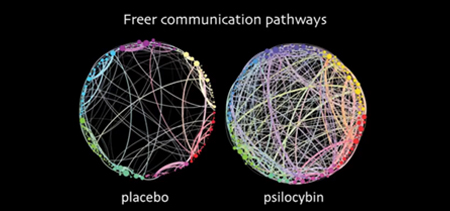
We might glimpse into what has been lost when we observe the expanded sensory and emotional capacities of children. As we grow older, these neural network connections appear to become ever more confined to limited, comfortable yet repetitive and restrictive loops. This would suggest that we experience through our senses only what we’ve conditioned ourselves to experience through our personal, ancestral and transpersonal imprinting.
Entheogens are reclaiming their rightful place as curative agents. Research studies for the treatment of depression, anxiety, addiction and PTSD (post-traumatic stress disorder) completed at John Hopkins, New York University (NYU), Imperial College of London and Multidisciplinary Association for Psychedelic Studies (MAPS), among others, are reporting excellent results, far exceeding the outcomes of most pharmaceutical drugs. But it is important to add that these medicines are not a magic bullet, guaranteeing curative outcomes for all. What we do know is that simply taking an entheogen, without proper preparation, psychological capacity, intention and optimal setting may engender an outcome less than desirable. Furthermore, within a comprehensive therapeutic protocol, post-session integration is essential. In these altered, expanded states, one may have an experience, or accept a narrative previously outside the scope of one’s purview, which may necessitate repeated understanding, refinement and integration.
In one case study (4), a marine returning from Afghanistan was thrust into a state of intractable depression. Through the therapeutic use of MDMA, guided by a caring, skilled husband and wife team, the ex-marine recognised that he had been frozen in guilt, unable to move past the atrocities he had witnessed and those he himself had committed. In an expanded state, induced through MDMA, he was able to arrive at another narrative. He recognised that he too had been a victim of a cause and a system much larger than himself. This insight allowed him to begin a process of healing through self-acceptance.
Along this continuum, a new and often more salutary narrative arises. Once sparked, it must be stabilised, reinforced. The integration process is the key to long-term positive result of psychedelic-assisted therapy.
Another hugely important factor is the actual quality of the experience. For some patients, clients or voyagers, it may simply be a novel or interesting inner adventure. For others, it might be referred to as a peak experience. While with still others, with proper preparation, in a sizeable portion of the population, patients experience a sense of ego dissolution, a merging into a sense of interconnection, a deeply meaning-making encounter, an experience often spoken of by mystics, that of a unity with all that there is (5).
In his book, Sacred Knowledge, Psychedelics and Religious Experiences, William A. Richards, clinical psychologist at Johns Hopkins Medical Centre, with formal training in theology and comparative religions, categorises mystical experiences into two major groups, based on the quality of the experience, that is, Internal Unity or External Unity. In this book he presents patient reports of mystical experiences while undergoing trial research studies on psilocybin to treat severe depression (6).
In this same book, Richards speaks of his own personal experience, while a participant of a psilocybin research study in the early 1960’s. He describes the after-effect of his fifth psilocybin session as follows:
“Relatively soon after psilocybin administration, the mystical forms of consciousness recurred in all their splendour, repeatedly drawing my being through several cycles of psychological death and rebirth, the noetic intensity of spiritual knowledge feeling etched into my brain. In the research report I subsequently wrote, there were terms such as, ‘cosmic tenderness’, ‘infinite love’, ‘penetrating peace’, ‘eternal blessing’, and ‘unconditional acceptance’, coupled with ‘unspeakable awe’, ‘overflowing joy’ ‘primeval humility’, ‘inexpressible gratitude’, and ‘boundless devotion’, all followed by the sentence, ‘Yet all of these words are hopelessly inadequate and do little more than meekly point toward the genuine, inexpressible feelings actually experienced (7).”
With experiences of a mystical nature, one enters a terrain beyond normal comprehension that one may have difficulty articulating its essence, lacking descriptive language, applicable references, analogies, etc. Yet these experiences produce transformative, enduring results. Repeatedly, various research centres report that the degree of therapeutic patient success correlated with the occurrence and degree of a mystical experience. In a controlled study performed at NYU, patients were struggling with depression, resulting from a terminal cancer diagnosis. After a single full dose of psilocybin, the research team reported that 80% of the participants experienced substantial sustained improvement, while 70% said it was one of their top five experiences. Some reported it was the single most meaningful experience of their lifetimes (8).
Ancient Buddhist metaphysical principle of Emptiness
Since the historical Buddha’s famous teaching on Emptiness, defined as the ‘ultimate nature of things’, Buddhist scholars have been studying, debating and contemplating the question: what is the ultimate nature of reality? Both the Diamond Cutter Sutra and the Heart Sutra, also known as ‘The Perfection of Wisdom’, contain profound teachings on this subject.
The Madhyamaka Prasangika school of Tibetan Buddhism, also referred to as the ‘Middle Way School’, of which one of its pre-eminent lineage holders is His Holiness the fourteenth Dalai Lama, has been considered authoritative on this topic. It posits that there is no self-existing reality out there, rather, we are continuously formulating our reality based on our projections, beliefs, concepts and pre-determined patterns. These pre-existing patterns shape our world and create our perceptions and the origin of our reality and its qualities are being forced upon us by our karmic imprints. We are locked into our particular reality and forced to view it as Truth!
As his Holiness explains, “… in contrast to the Mind-only School, the Middle Way School reads the Perfection of Wisdom as definitive, accepting the statement that “all things and events are devoid of any intrinsic existence” as literal. The Middle Way view does not discriminate between the existential status of subject and object — between mind and world. The Hundred Thousand Verses on the Perfection of Wisdom explicitly presents this view with the statement that, on the ultimate level, all phenomena do not exist. So, for the Middle Way School, the Perfection of Wisdom sutra remain literal, and the emptiness of all phenomena becomes definitive (9).”
There are a number of other Buddhist schools with varying interpretations on Emptiness. Though they differ considerably, what they agree on is that reality does not exist as it appears to us out there or in here.
This premise, that the mind is malleable, vast, largely untapped and that we live in limited chambers of existence with limited modes of fixed perception, holds both ominous and thrilling implications. From a discomfiting perspective, even when a belief is founded on unsubstantiated factors or illogical reasoning, it nonetheless has the potential to be deemed as true and eventually becomes integral to one’s personal and collective belief-system. It was not too long ago that the world was believed to be flat and women healers considered witches. In our challenging times, where it sometimes seems that fundamental truths and logic do not apply and easily disproven lies are marshalled to suit self-serving agendas, the effect can be dumbfounding. However, the human potential to upend, disrupt and re-imagine received wisdom and the status quo is exhilarating.
Current psychological principles
Psychoanalysis and psychotherapy are disciplines founded on the belief that we humans possess innate transformational potential. This view has found acceptance in mainstream Western mental health as a proven and legitimate healing modality. It is commonly held that the effectiveness of pharmacological drugs is highly enhanced, if not mainly dependent on the psychotherapeutic process.
To further illustrate how both conscious and unconscious forces can reshape the inner reality of an individual, I present here a clinical case study.
Catherine was in her early 30’s when I first started seeing her and although highly functional, attractive and successful, holding a corporate position in New York City, she suffered from low self-esteem, internalised anger and an eating disorder. Raised in a Roman Catholic household imbued with a strong sense of duty and sacrifice, her maternal role-models found a sense of self-worth in withstanding the harsh consequences of life with dignity and worth through a victim/martyr complex. Catherine was a parentified child, encouraged to put the needs of others before her own. By the time we started our work, she had lost touch with her needs and desires, which profoundly negatively impacted all of her relationships.
Through a process of introjection, Catherine had in essence internalised the negligent mother. She paid no attention to her own needs but rather gave to others to the point of exhaustion and repressed anger and resentment. Introjection is a term that describes a psychic process whereby one internalises, absorbs inwardly — both consciously and unconsciously, negatively or positively — emotions, beliefs and self-image.
Catherine required the attention of a loving, caring ‘Other’, someone who acknowledged her needs and value apart from her sacrificing self. Through the process of transference, Catherine was able to shift the constellation of dynamics associated with her mother to her analyst. Transference is a mechanism by which a complex, a constellation of dynamics, feelings and desires, originally associated with one person, such as a parent, are unconsciously shifted to another.The therapeutic psychoanalytical process of Object Relations was further applied. This theory posits that the way people relate to others and situations in their adult lives, is often shaped by family experiences during infancy and early childhood. Since Catherine was open to a transpersonal dimension, that is, dimensions beyond her personal narrative, these factors were also brought into the work giving further meaning and understanding to her present condition.
Catherine eventually came to understand that her relationship with her mother was life-negating, laden with a heavy sense of guilt, obligation and dread. She slowly pulled away from her habitual patterns of always showing up, at no matter what the personal price, without examining her options; without asking the question, how can I still be a loving daughter and a caring human being without automatically assuming the role of protector and exclusive caregiver? Catherine had five siblings.
During our work Catherine also had the insight to walk away from a marriage proposal that would have landed her in the same relational dynamic as that with her mother. She came to understand that this self-sacrificing role was one that she continued to replicate with her partners, bosses, siblings and friends, always caving into their needs and not asserting her own. And it was not as if drive, power and assertion were not part of her nature. She had a strong sense of personal power and inner-assertion, clearly apparent in her passion for human and social justice and her love for nature and the planet.
Catherine has reached a place of greater self-acceptance; a place where she is comfortable with her introverted personality, her body, her lifestyle, which is radically different from the one she grew up in. Although she is frequently sought out by friends and family, she will often opt for the things that she enjoys, without sacrificing her sense of an appropriate care for others.
Returning to the issue of Real and Reality, viewed through the lens of a psychological therapeutic application, what we again see is that reality is not fixed but rather can be malleable through a process of inner restructuring.
Having touched on the issue of Real and Reality from several angles, that is, cutting-edge science, Buddhism’s understanding of ultimate reality and psychology’s contribution of projections, transference and internalisation, I would argue that all these disciplines point to the suggestion that reality is not fixed, out there, but rather is fluid, malleable, open to possibilities, ‘A Becoming’, a verb not a noun.
If we posit that the above is true, that there is No Real and that there is No fixed Reality, then the question remains, where do we go from here, what do we do with that knowing? How do we, as concerned participants in this human family, make choices that engender the betterment of our collective society, our culture, our planet? How do we work towards a positive evolutionary trajectory?
I would argue that the choices we make do make a difference in our Becoming.
In that spirit, I would argue that we choose enlightened values, humanism, and morality. Western civilisation suffers from a crisis of identity; a loss of greater purpose, no longer guided by a collective myth. Nietzsche‘s proclamation, “God is Dead” feels prescient. In a time when religion, as we have known it, is being transformed, we might be well served to reinvigorate altruism in our children, and ourselves.
I would argue that we revive our awe at the mystery and beauty of nature, see nature as a mirror into ourselves. That we not only model but become exemplars of civic duty and planetary stewardship for our children.That we learn to listen and respect our children and demand that they develop the art of listening, patience and respect for others and the planet. That we demonstrate a healthy work ethic, vibrantly balanced with soulful leisurely pursuits. That we encourage our children to revere their elders for their accumulated knowledge and wisdom.
I would argue that each of us strive to expand our consciousness. To be awake, aware and engaged with life. That we cultivate a relationship with our inner selves.That we find this connection in ways that uniquely speak to us. That we discover and cultivate a space for our inner-being, whether through meditation, journaling, encounters with nature, sacred daily rituals, enlightened travel, friendship, conversation, precious solitude, immersion in art, poetry, music, dance or movement.
I would argue the need to nurture a sense of curiosity, exploration and presence so that the quality of awe and wonder that we experience under the influence of sacred medicines become more of the lens through which we experience the world.
I would argue that in a world obsessed with materialism and possessed by the virus of consumerism, we burst beyond its shallow constraints.
I would argue that in a culture languishing in a dreamlike state of denial around Death, we devote ourselves to ongoing reflections on impermanence, the ever-changing nature of existence. That we contemplate and embrace Death, as the ultimate guide and friend who awaits us just around the corner.
Entheogens have been used by ingenious people for thousands of years as vehicles to pierce the veil of perception and to heal. Today, patients return to recount experiences of ego-dissolution, non-dual being, interconnection, joy, peace, love. In a time when egotism, bullying and arrogance are widespread globally, is perhaps the return of the use of sacred entheogens a self-regulating planetary impulse necessary to restore balance towards a more humane and enlightened world?
If the hypothesis that our choices do make a difference resonates with our deeper gnosis, that our actions have consequences, both personally and collectively, that they determine the direction of the future evolutionary impulse, then the importance of every action we take, every word we utter, every thought we engage in, every option we choose takes on a vastly greater significance. And while all of this may sound like a very high order, an unattainable, unreachable level of aspiration, I am reminded of Lao Tzu’s simple yet elegant saying, “The journey of a thousand miles begins with the first step”.
Here,we might turn and ask the questions:
Will we stay limited in our comfortable, confining mental constructs or will we strive for an ever- expanding gnosis?
Will we see and glimpse into the inter-connection of all human beings and the co-dependent arising of all living things, or do we remain imprisoned in our skin-encapsulated egos?
Will we be able to perceive the aliveness and interdependence of all that composes this delicate planet, or will we instead continue to consider her an inanimate object to dominate, use and abuse for our pleasure and gain?
Will we be open to re-imagining a future ‘Becoming’?
These I believe, are the questions that must burn at the heart of each of us until they spark a flame that blazes a wild fire of concern, passion and action, lighting a torch within each of us that will fuel our collective Becoming.
References
1. Entheogen. Wikipedia.[Online] Available from:https://en.wikipedia.org/wiki/Entheogen [Accessed 24th February 2020].
2. Cahart-Harris RL, Erritzoe D, Williams T et al. Neural correlates of the psychedelic state as determined by fMRI studies with psilocybin. Proceedings of the National Academy of Sciences, January 23, 2012 DOI: 10.1073/pnas.1119598109.
3. Ibid.
4. Author’s own notes, 23-29 June, 2019. Case studies presented at week-long training given by Mithoefer M, Mithoefer A as part of CPTR programme (Certificate in Psychedelic Therapy & Research) offered by The California Institute of Integral Studies, San Francisco (CIIS)
5. Author’s own notes, 4 May, 2019.Lecture by Bossis A as part of CPTR programme (Certificate in Psychedelic Therapy & Research), offered by CIIS.
6. Richard WA. SacredKnowledge, Psychedelics and Religious Experiences. New York: NYU Press; 2016, pp. 58-68.
7. Ibid., pp. 32-33.
8. Ross S, Bossis A, Guss J et al. Rapid and sustained symptom reduction following psilocybin treatment for anxiety and depression in patients with life-threatening cancer: a random controlled trial Journal of Psychopharmacology 2016; 30(12): 1165-1180.
9. Tenzin Gyatso, the 14th Dalai Lama. (translated and edited by Jinpa GT). Essence of the Heart Sutra; Heart of Wisdom Teachings. Boston MA: Wisdom Publications; 2002, pp. 106-107.
Dorathea Thompson is an integrative psychoanalyst in private practice in New York City.
Share with us (Comments,contributions,opinions)
When reproducing this feature, please credit NAMAH,and give the byline. Please send us cuttings.

